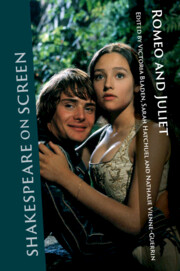Book contents
- Shakespeare on Screen: Romeo and Juliet
- Series page
- Shakespeare on Screen: Romeo and Juliet
- Copyright page
- Dedication
- Contents
- Figures
- Notes on Contributors
- Series Editors’ Preface
- Acknowledgements
- Chapter 1 Introduction – From Canon to Queer: Romeo and Juliet on Screen
- Part I Revisiting the Canon
- Part II Extending Genre
- Chapter 6 Romeo and Juliet and the Western
- Chapter 7 Pixarfication, Comedy and Earning the Happy Ending in Gnomeo & Juliet
- Chapter 8 Decentring the Hypotext with Denim and Zombies: Jonathan Levine’s Warm Bodies (2013) and David Lachapelle’s Romeo & Juliet (2005)
- Chapter 9 Guns, Rasa and Roses: Sanjay Leela Bhansali’s Ram-Leela (2013), a ‘Desi’ Romeo and Juliet
- Chapter 10 Indian Romeo and Juliets and Their Uncommonly Tragic Endings
- Part III Serial and Queer Romeo and Juliets
- Index
- References
Chapter 10 - Indian Romeo and Juliets and Their Uncommonly Tragic Endings
from Part II - Extending Genre
Published online by Cambridge University Press: 10 October 2023
- Shakespeare on Screen: Romeo and Juliet
- Series page
- Shakespeare on Screen: Romeo and Juliet
- Copyright page
- Dedication
- Contents
- Figures
- Notes on Contributors
- Series Editors’ Preface
- Acknowledgements
- Chapter 1 Introduction – From Canon to Queer: Romeo and Juliet on Screen
- Part I Revisiting the Canon
- Part II Extending Genre
- Chapter 6 Romeo and Juliet and the Western
- Chapter 7 Pixarfication, Comedy and Earning the Happy Ending in Gnomeo & Juliet
- Chapter 8 Decentring the Hypotext with Denim and Zombies: Jonathan Levine’s Warm Bodies (2013) and David Lachapelle’s Romeo & Juliet (2005)
- Chapter 9 Guns, Rasa and Roses: Sanjay Leela Bhansali’s Ram-Leela (2013), a ‘Desi’ Romeo and Juliet
- Chapter 10 Indian Romeo and Juliets and Their Uncommonly Tragic Endings
- Part III Serial and Queer Romeo and Juliets
- Index
- References
Summary
In this chapter, I focus on the Bengali-language Arshinagar (2015) directed by Aparna Sen, and the Hindi-language Dhadak (2018) written and directed by Shashank Khaitan. Both films are adaptations of Romeo and Juliet that place the play within the context of current socio-political issues of communalism and honour killings in India.
Keywords
- Type
- Chapter
- Information
- Shakespeare on Screen: Romeo and Juliet , pp. 155 - 168Publisher: Cambridge University PressPrint publication year: 2023

